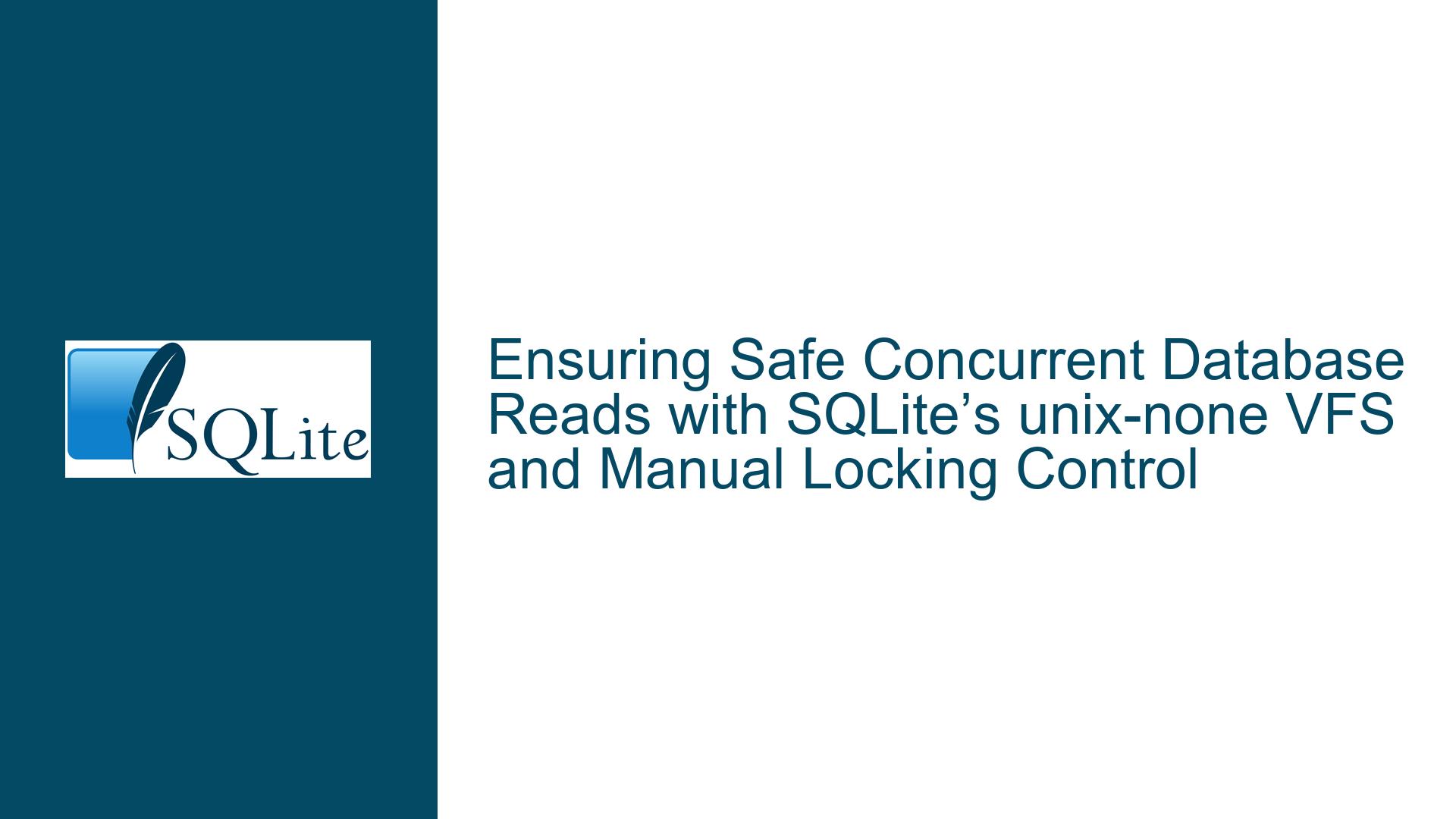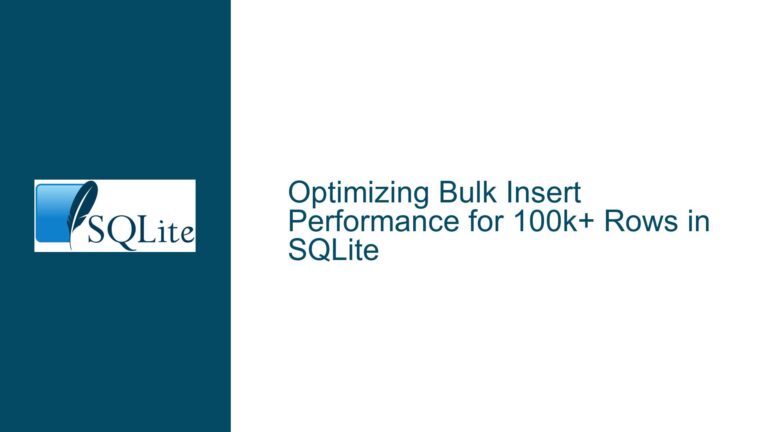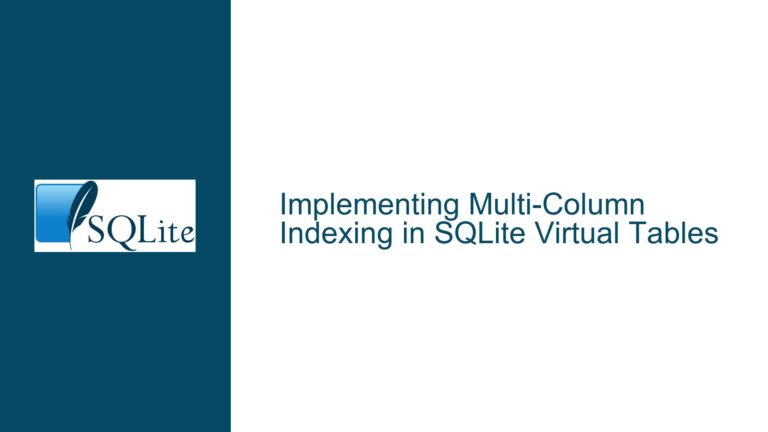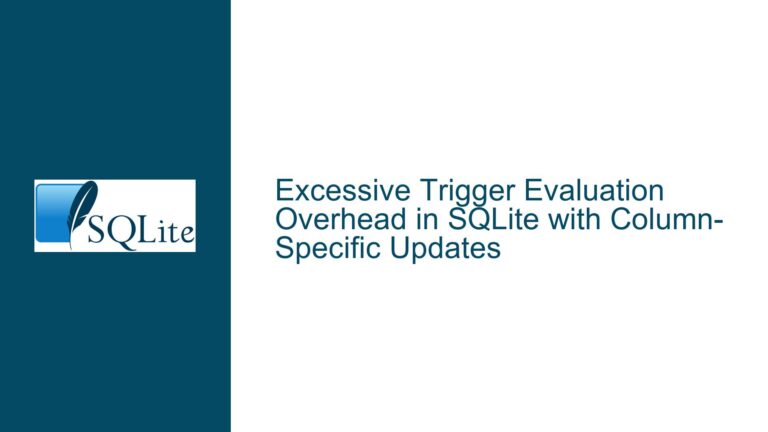Ensuring Safe Concurrent Database Reads with SQLite’s unix-none VFS and Manual Locking Control
Understanding SQLite’s Locking Mechanisms and the Role of unix-none VFS
SQLite is designed to handle concurrent access through its locking subsystem, which relies on the underlying Virtual File System (VFS) to enforce file-level locks. By default, SQLite uses advisory locks to coordinate read and write operations across multiple threads or processes. These locks are implemented using OS-specific mechanisms such as flock (file locking) or POSIX advisory locks. However, when these mechanisms are unavailable—as in environments lacking support for flock or POSIX locks—developers may consider alternative VFS configurations, such as the unix-none VFS, which bypasses SQLite’s internal locking logic entirely.
The unix-none VFS is a minimalist implementation that removes all file-locking code, effectively delegating concurrency control to the application layer. This approach can theoretically work if the application guarantees that reads and writes never overlap. For example, if a single thread or process exclusively handles writes while other threads/processes are restricted to reads, and strict synchronization ensures no overlap, the absence of SQLite’s internal locks might not immediately cause issues. However, SQLite’s architecture assumes that locking is enforced by the VFS. Removing this layer introduces risks, particularly in scenarios where the application’s concurrency control logic is imperfect or untested.
The critical challenge lies in ensuring that the application’s manual synchronization is flawless. SQLite transactions rely on locks to maintain atomicity and isolation. Without locks, even a momentary overlap between a read and a write operation—such as a writer modifying a page while a reader is accessing it—can result in torn pages, corrupted indices, or inconsistent query results. The unix-none VFS does not provide atomicity guarantees; it merely disables SQLite’s attempt to enforce them. Consequently, the burden of ensuring atomic operations shifts entirely to the developer.
Risks and Pitfalls of Manual Concurrency Control in SQLite
The decision to use unix-none VFS hinges on the assumption that the application can perfectly coordinate access to the database file. However, several factors complicate this assumption:
Thread Scheduling and Race Conditions: Modern operating systems use preemptive multitasking, where threads can be paused or resumed at arbitrary points. If a write operation is interrupted mid-execution, a read operation might access partially written data. For example, a thread executing
UPDATE table SET column = value WHERE id = 1might be paused after modifying the database file’s first block but before completing the transaction. A concurrent read operation could then read an inconsistent state, even if the application’s logic assumes writes are atomic.File System Caching and Buffering: SQLite relies on the file system’s buffering behavior to ensure that changes are written in a specific order. The
unix-noneVFS does not override default buffering policies. If the file system reorders writes or delays flushing buffers, readers might observe stale data or partial updates, even if the application’s logic enforces a strict write-then-read order.Transaction Rollbacks and Journaling: SQLite uses write-ahead logging (WAL) or rollback journals to implement atomic transactions. These mechanisms depend on file locks to prevent conflicting access during journal commits or WAL checkpointing. Disabling locks via
unix-noneVFS can lead to scenarios where a transaction’s journal is deleted or truncated while another process is reading from it, resulting in database corruption.Hidden Dependencies on Locking: Certain SQLite features, such as
BEGIN IMMEDIATEorBEGIN EXCLUSIVEtransactions, implicitly rely on the VFS’s locking behavior. Withunix-none, these statements become no-ops, potentially leading to deadlocks or missed synchronization points in applications that depend on them.
Strategies for Safe Concurrent Access with unix-none VFS and External Coordination
To mitigate the risks of using unix-none VFS, developers must implement rigorous external coordination mechanisms. Below is a structured approach to achieving this:
Step 1: Validate the Operating Environment and Requirements
Before opting for unix-none, confirm that the target environment lacks support for standard locking mechanisms. Use SQLite’s PRAGMA locking_mode and diagnostic tools like strace (Linux) or dtruss (macOS) to verify that system calls for flock or fcntl are unavailable or unreliable. If the environment supports alternative locking primitives (e.g., named semaphores or mutexes), consider implementing a custom VFS that integrates these instead of disabling locks entirely.
Step 2: Design a Global Locking Protocol
Implement a global locking mechanism outside SQLite to enforce exclusive write access. For example:
- Use a separate lock file or a named semaphore to indicate when a write operation is in progress.
- Readers must check the lock before opening a database connection and wait if a write is ongoing.
- Writers must acquire the lock before beginning a transaction and hold it until the transaction is fully committed.
This protocol must be enforced at the application level, with no exceptions. All database access code paths—including error handlers and cleanup routines—must adhere to the locking rules.
Step 3: Disable SQLite’s Internal Concurrency Features
Configure SQLite to operate in single-threaded mode using PRAGMA threadsafe=0 and ensure that all connections use the same thread. This reduces the risk of internal race conditions within SQLite’s own code. Additionally, disable WAL mode (PRAGMA journal_mode=DELETE) to avoid complications with write-ahead logging, which assumes lock-based coordination.
Step 4: Implement Application-Level Transaction Checks
Modify the application to include pre-transaction validation. For example:
- Before executing a write transaction, verify that no other threads or processes have an open connection.
- Use a shared counter or reference count to track active readers and block writers until the count reaches zero.
Step 5: Rigorous Testing and Fault Injection
Simulate worst-case scenarios to uncover edge cases in the locking logic:
- Force context switches during critical sections using tools like
Chaos Monkeyor custom debug hooks. - Test recovery procedures after application crashes or power failures to ensure the database remains consistent.
- Use SQLite’s
sqlite3_test_controlinterface to inject I/O errors and validate error-handling paths.
Step 6: Continuous Monitoring and Fallbacks
Instrument the application to log all lock acquisitions, releases, and violations. Monitor these logs for patterns that indicate race conditions or unexpected behavior. Implement fallback mechanisms, such as reverting to a read-only mode or switching to an in-memory database, if the external locking system fails.
Alternative Approach: Use an In-Memory Database with Shared Cache
If the primary use case is concurrent reads, consider loading the database into an in-memory instance with sqlite3_open_v2 and the SQLITE_OPEN_MEMORY flag. Combine this with SQLITE_OPEN_SHAREDCACHE to allow multiple connections to share the same cache. This approach avoids file locking entirely but requires sufficient RAM to hold the entire database.
By meticulously following these steps, developers can theoretically achieve safe concurrent reads with unix-none VFS. However, the complexity and brittleness of such a system often outweigh its benefits. In most cases, a better solution is to use a database engine designed for high concurrency (e.g., PostgreSQL) or to restructure the application to minimize concurrent access demands. If SQLite is mandatory, upgrading to an environment with proper locking support or leveraging SQLite’s built-in concurrency features (e.g., WAL mode with SQLITE_CONFIG_SERIALIZED) remains the safest path.





